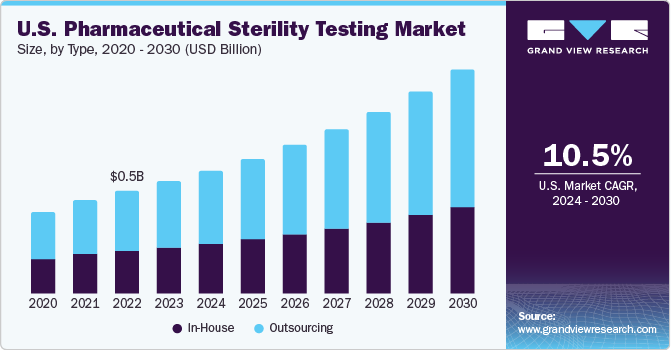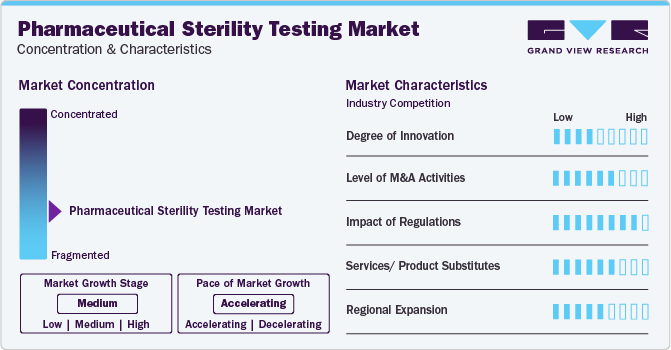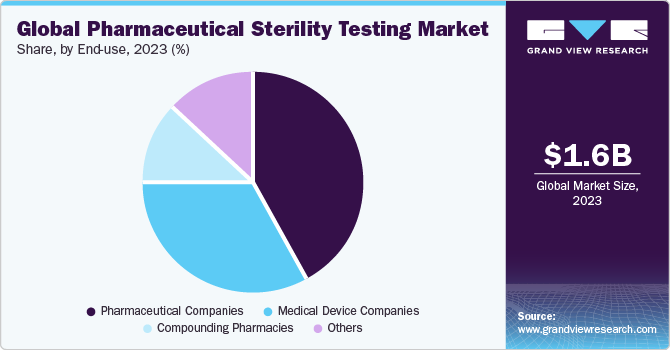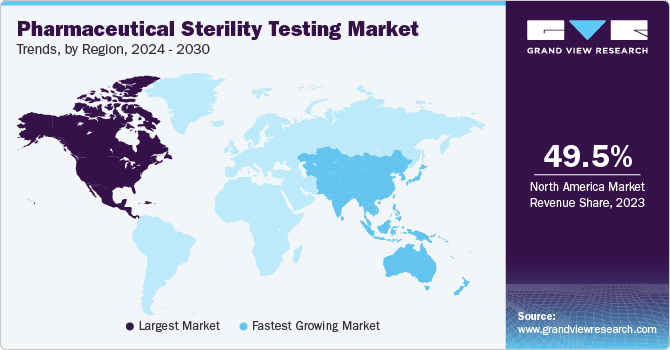- Home
- »
- Clinical Diagnostics
- »
-
Pharmaceutical Sterility Testing Market Size Report, 2030GVR Report cover
![Pharmaceutical Sterility Testing Market Size, Share & Trends Report]()
Pharmaceutical Sterility Testing Market Size, Share & Trends Analysis Report By Type (Outsourcing, In-house), By Product Type, By Test Type, By Sample, By End-use, By Region, And Segment Forecasts, 2024 - 2030
- Report ID: GVR-2-68038-425-3
- Number of Report Pages: 267
- Format: PDF, Horizon Databook
- Historical Range: 2018 - 2022
- Forecast Period: 2024 - 2030
- Industry: Healthcare
Market Size & Trends
The global pharmaceutical sterility testing market size was estimated at USD 1.59 billion in 2023 and is projected to grow at a compound annual growth rate (CAGR) of 11.02% from 2024 to 2030. Increasing government investments, R&D activities, a growing number of drug launches, and a rising focus on quality & sterility are expected to drive the market growth. The development of comprehensive sterility testing procedures is regulated with stringent policies and quality control standards.

In addition, several government initiatives play a pivotal role in shaping the healthcare landscape, and their financial support significantly influences the development & implementation of advanced sterility testing procedures within the pharmaceutical sector. Increasing government funding for enhanced R&D activities for novel therapeutics, especially vaccines, biologics, and sterile products, which need sterility testing to ensure safety & efficacy. This leads to the introduction of cutting-edge technologies and innovative solutions in the sterility testing market. For instance, according to the European Federation of Pharmaceutical Industries and Associations (EFPIA), total healthcare R&D expenditure in the European Union (EU) was around USD 48.5 billion in 2022 compared to USD 46.4 billion in 2021.
Market Concentration & Characteristics
Market growth stage is stable, and market growth is expected to accelerate over the estimated time period. The market is characterized by evolving technologies, materials innovation, regulatory considerations, and globalization & outsourcing of services processes to influence cost advantages, and specialized capabilities.

Rising innovations & the development of new products are directly linked to the demand for testing services. The increasing outsourcing of these services, attributed to pricing concerns, and competitive pressure drives market growth. The development of innovative medicines has fueled demand for specific types of tests.
Regulatory bodies and other health authorities can greatly influence the global market. These regulatory bodies regularly conduct inspections to ensure compliance of the manufacturing units and contract manufacturing units with quality standards. In addition, the compliance standards, and industry guidelines drives market growth.
Competitive strategies of competitors within the global market are crucial influences. Understanding the competitive landscape helps businesses position themselves effectively and differentiate their offerings.
Increasing government investments, R&D activities regarding the safety and quality of pharmaceutical products & rising number of drug launches can influence market dynamics positively.
Changes in global healthcare trends, emerging markets, and shifts in research priorities can impact the demand for pharmaceutical sterility testing. Analyzing market influencers involves understanding the broader industry trends that may shape the market.
Type Insights
Based on type, the outsourcing segment led the market with the largest revenue share of 59.25% in 2023. The market is classified into in-house, and outsourcing. Outsourcing sterility testing is considered an attractive alternative for several small- & medium-sized pharmaceutical and medical device companies, which may lack the infrastructure to conduct quality sterility testing. Most of these companies, therefore, prefer to outsource sterility testing services to fulfill the FDA requirements, which is likely to impel the growth of this segment.
The in-house pharmaceutical sterility testing segment is anticipated to grow at a lucrative CAGR during the forecast period. The segment growth is driven by increasing requirements for product safety and growing demand for testing services to assess the compatibility & validation of products with routine quality test & control. Moreover, in-house sterility testing requires high control levels with respect to Good Laboratory Practices (GLP), Good Manufacturing Practices (GMP), and employee & environmental practices.
Product Type Insights
Based on product type, the kits & reagents segment held the market with the largest revenue share of 60.30% in 2023. The market is segregated into kits and reagents, instruments, and services. In pharmaceuticals and medical devices, for performing sterility testing, a new, fresh kit is required every time. The segment is driven by growing consumption of kits & reagents used in sterility testing, rising prevalence of diseases, growing R&D investments, development of advanced & cost-effective technologies, and growing applications of sterility & molecular testing. Besides, growing demand for new therapeutics globally is expected to further support the demand for market growth.
The service segment is anticipated to grow at a fastest CAGR of 10.80% during the forecast period. The growing prevalence of diseases, increasing R&D activities, rising government investments in the healthcare industry, growing drug pipelines, and a rising focus on quality & sterility are expected to drive the market growth.
Test type Insights
Based on test-type, the bioburden testing segment held a market with the largest revenue share of 41.71% in 2023. The market is segregated into sterility testing, bioburden testing, and bacterial endotoxin testing. Sterility testing is further bifurcated into membrane filtration, direct inoculation, and product flush. The bioburden testing segment is driven by strict quality control processes and the demand for testing to quantify microbial contamination of a product at different stages of production from initial manufacturing to final distribution. This testing is commonly performed by the pharmaceutical & medical industries for quality control testing of pharmaceutical & medical products. It is performed for sterile drugs, biologics, and all medical devices, including classes I, II, and III. This ensures that pharmaceuticals & medical devices meet the global stringent health and safety regulations created by Title 21 of the Code of Federal Regulations in the USA and by ISO 11737.
In addition, the sterility testing market is anticipated to witness a fastest CAGR during the forecast period. Sterility testing is widely used to confirm products’ sterility for the pharmaceutical, biopharmaceutical, and medical device industries. The segment growth can be attributed to industry requirement for sterility testing during the sterilization validation process, as well as for routine release testing.
Sample Insights
Based on sample, thepharmaceuticals companies segment held the market with the largest revenue share of 42.45% in 2023. The market is segregated into pharmaceuticals, medical devices, and biopharmaceuticals. The pharmaceutical industry is subject to strict regulatory requirements, and sterility testing is critical to ensure compliance with regulatory standards such as Good Manufacturing Practices (GMP). Outsourcing sterility testing to specialized laboratories helps pharmaceutical companies meet these stringent regulatory requirements without investing heavily in specialized facilities and personnel. Pharmaceuticals encompass various dosage forms, such as parenteral solutions, aerosols, ointments, eye drops, and other formulations.
The biopharmaceuticals segment is expected to grow at a fastest CAGR of 12.52% over the forecast period. The biopharmaceutical sector, including biologics and biosimilars, has been expanding. These products often require specialized testing services, including sterility testing. There is a growing demand for biologics and biosimilar drugs in the U.S. as they are highly effective in treating serious diseases like cancer, autoimmune diseases, neurological disorders, and others. The COVID-19 pandemic increased the demand for vaccines in the country, and due to this, in July 2022, the U.S. government secured 3.2 million doses of the Novavax COVID-19 Vaccine. Such initiatives are expected to drive the demand for biopharmaceutical sterility testing.
End-use Insights
Based on end-use, the pharmaceutical companiessegment held a market with the largest revenue share of 42.45% in 2023. The market is segregated into compounding pharmacies, medical devices companies, pharmaceutical companies, and others. Pharmaceutical companies are required to conduct sterility tests on pharmaceutical formulations/devices to ensure the safety of products, especially for oral dosage forms, as most of these products are ingested by patients. In addition, specific guidelines are set in the pharmacopeia of each country, which describe the necessary sterility tests that are required to be performed for a given drug. With increasing demand for pharmaceutical products, companies are required to maintain highly regulated manufacturing conditions to ensure sterility of their products.

The compounding pharmacies are expected to grow at a fastest CAGR of 12.20% over the forecast period. Compounding pharmacies prepare customized dosages of sterile drugs, which are required to comply with the stringent requirements and standards of sterility. Sterility testing supports compounding pharmacies in maintaining control & consistency and reducing risks associated with manufacturing in an aseptic environment.
Regional Insights
North America dominated the market with the revenue share of 49.45% in 2023. This is attributed to the increasing number of pharmaceutical industries, and presence of a number of major market players within the U.S. and Canada. The expansion of the market can be ascribed to the existence of technologically advanced CROs & CDMOs and an upsurge in the allocation of grants. The increasing prevalence of diverse diseases has led to additional investments in clinical research throughout the projected period. Furthermore, heightened drug development endeavors, strategic measures like innovation & acquisitions, presence of pharmaceutical and biotech firms, and a surge in number of clinical trials in the region are key factors propelling market growth.

U.S. Pharmaceutical Sterility Testing Market Trends
The pharmaceutical sterility testing market in the U.S. held the largest share in 2023. An increase in R&D activities and a rise in the number of drug approvals in the country are among the major factors supporting the market growth.
Europe Pharmaceutical Sterility Testing Market Trends
The Europe pharmaceutical sterility testing market is expected to grow significant CAGR during the forecast period, due to a growing regulations. These regulatory bodies regularly conduct inspections to ensure compliance of the manufacturing units and contract manufacturing units with quality standards which is expected to contribute to the increasing demand for pharmaceutical sterility testing in this region.
The pharmaceutical sterility testing market in Germany held the largest share in 2023, owing to increased requirement for improved product designs and related services. Advancements in technology & quality clinical resources are some of the key factors propelling market growth over the forecast period.
The UK pharmaceutical sterility testing market is anticipated to grow at the fastest CAGR over the forecast period. The UK is of prime importance for pharmaceutical companies, which is expected to contribute to extensive R&D initiatives and clinical trials being undertaken to address the challenges posed by various diseases
Asia Pacific Pharmaceutical Sterility Testing Market Trends
The pharmaceutical sterility testing market of Asia Pacific is expected to grow at the fastest CAGR over the forecast period, due to numerous developed countries investing in Asia Pacific countries and various amendments made by the regulatory agencies to facilitate local manufacturing & contract services. The growing healthcare demand due to rising population is also anticipated to accelerate the drug approval process, indirectly facilitating the pharmaceutical sterility testing market in Asia Pacific. Furthermore, harmonization of the regulatory standards of these regions with the International Council for Harmonization of Technical Requirements for Pharmaceuticals for Human Use (ICH) standards is anticipated to fuel market growth.
The China pharmaceutical sterility testing market held the largest share in 2023. Besides, the country has become an attractive destination for outsourcing clinical trials due to its large population, diverse patient demographics, and cost-effectiveness. As a result, domestic and international pharmaceutical companies outsource their clinical trials to Contract Research Organizations (CROs) in China, driving the demand for sterility testing services.
The pharmaceutical sterility testing market of Japan is expected to grow at the fastest CAGR over the forecast period, due to commencement of the development & manufacturing services for messenger Ribonucleic Acid pharmaceuticals, biopharmaceuticals produced through gene & cell therapies and mammalian cell cultures in 2026.
The India pharmaceutical sterility testing market is anticipated to grow at the fastest CAGR over the forecast period. This can be attributed to low costs, the availability of industry experts, and presence of WHO-cGMP-compliant facilities. Besides, increasing government funding for R&D to accelerate new product development is expected to improve the number of new drugs, promoting the demand for pharmaceutical sterility testing in India.
Key Pharmaceutical Sterility Testing Company Insights
Several key players are acquiring various strategic initiatives to strengthen their market position offering diverse services to customers. The prominent strategies adopted by companies are service launches, mergers & acquisitions/joint ventures merger, partnership & agreements, expansions, and others to increase market presence & revenue and gain a competitive edge drives the market growth.
Key Pharmaceutical Sterility Testing Companies:
The following are the leading companies in the pharmaceutical sterility testing market. These companies collectively hold the largest market share and dictate industry trends. Financials, strategy maps & products of these pharmaceutical sterility testing companies are analyzed to map the supply network.
- Pacific Biolabs
- Steris Plc
- Boston Analytical
- Sotera Health Company (Nelson Labs)
- Sartorius Ag
- Solvias Ag
- SGS SA
- Labcorp
- Pace Analytical
- Charles River Laboratories
- Thermo Fisher Scientific, Inc.
- Rapid Micro Biosystems, Inc.
- Almac Group
- Labor LS SE & Co. KG
Recent Developments
-
In January 2024, Rapid Micro Biosystems, Inc. company announced the launch of the Growth Direct Rapid Sterility application by mid-2024
-
In August 2023, Pace Analytical Services improved its capabilities by adding advanced hydrocarbon analytical support and expanded sediment & tissue testing with the acquisition of Alpha Analytical
-
In May 2023, Thermo Fisher Scientific, Inc. announced the launch of a sterile drug facility in Singapore. It would help deliver new vaccines and medicines in the Asia Pacific market
Pharmaceutical Sterility Testing Market Report Scope
Report Attribute
Details
Market size value in 2024
USD 1.75 billion
Revenue forecast in 2030
USD 3.28 billion
Growth rate
CAGR of 11.02% from 2024 to 2030
Base year for estimation
2023
Historical data
2018 - 2022
Forecast period
2024 - 2030
Quantitative units
Revenue in USD million/billion and CAGR from 2024 to 2030
Report coverage
Revenue forecast, company ranking, competitive landscape, growth factors, and trends
Segments covered
Type, product type, test type, sample, end-use, region
Regional scope
North America; Europe; Asia Pacific; Latin America; MEA
Country scope
U.S.; Canada; UK; Germany; France; Italy; Spain; Netherlands; Switzerland; Sweden; Belgium; Japan; China; India; Australia; South Korea; Philippines; Malaysia; New Zealand; Singapore; Thailand; Brazil; Mexico; Argentina; Colombia; Chile; South Africa; Saudi Arabia; Egypt; Israel; UAE
Key companies profiled
Pacific Biolabs; Steris Plc; Boston Analytical; Nelson Laboratories; LLC (Sotera Health); Sartorius AG; SOLVIAS AG; SGS SA; Labcorp; Pace Analytical; Charles River Laboratories; Thermo Fisher Scientific, Inc.; Rapid Micro Biosystems; Almac Group;Labor LS SE & Co; KG
Customization scope
Free report customization (equivalent up to 8 analyst’s working days) with purchase. Addition or alteration to country, regional & segment scope.
Pricing and purchase options
Avail customized purchase options to meet your exact research needs. Explore purchase options
Global Pharmaceutical Sterility Testing Market Report Segmentation
This report forecasts revenue growth at global, regional, and country levels and provides an analysis of the latest industry trends in each of the sub-segments from 2018 to 2030. For this study, Grand View Research has segmented the global pharmaceutical sterility testing market report based on the type, product type, test type, sample, end-use, and region:
-
Type Outlook (Revenue, USD Million, 2018 - 2030)
-
In-House
-
Outsourcing
-
-
Product Type Outlook (Revenue, USD Million, 2018 - 2030)
-
Kits & Reagents
-
Instruments
-
Services
-
-
Test Type Outlook (Revenue, USD Million, 2018 - 2030)
-
Sterility Testing
-
Membrane Filtration
-
Direct Inoculation
-
Product Flush
-
-
Bioburden Testing
-
Bacterial Endotoxin Testing
-
Rapid Microbial Method
-
ATP Bioluminescence
-
Fluorescent -Based
-
Solid-phase Cytometry
-
Others
-
-
-
Sample Outlook (Revenue, USD Million, 2018 - 2030)
-
Pharmaceuticals
-
Medical Devices
-
Biopharmaceuticals
-
-
End-use Outlook (Revenue, USD Million, 2018 - 2030)
-
Compounding Pharmacies
-
Medical Device Companies
-
Pharmaceutical Companies
-
Others
-
-
Regional Outlook (Revenue, USD Million, 2018 - 2030)
-
North America
-
U.S.
-
Canada
-
-
Europe
-
UK
-
Germany
-
France
-
Italy
-
Spain
-
Netherlands
-
Switzerland
-
Sweden
-
Belgium
-
Russia
-
-
Asia Pacific
-
Japan
-
China
-
India
-
Australia
-
South Korea
-
Philippines
-
Malaysia
-
New Zealand
-
Singapore
-
Thailand
-
-
Latin America
-
Brazil
-
Mexico
-
Argentina
-
Colombia
-
Chile
-
-
Middle East and Africa (MEA)
-
South Africa
-
Saudi Arabia
-
Egypt
-
Israel
-
UAE
-
-
Frequently Asked Questions About This Report
b. The global pharmaceutical sterility testing market size was estimated at USD 1.59 billion in 2023 and is expected to reach USD 1.75 billion in 2024.
b. The global pharmaceutical testing sterility market is expected to grow at a compound annual growth rate of 11.02% from 2024 to 2030 to reach USD 3.28 billion by 2030.
b. North America dominated the Pharmaceutical sterility testing market with a share of 49.4% in 2023. This is attributed to the increasing number of pharmaceutical industries within the U.S. & Canada, and the increasing presence of the number of major market players this region is expected to contribute significantly to the market growth.
b. Some key players operating in the pharmaceutical testing sterility market include SPacific Biolabs, Steris Plc, Boston Analytical, Nelson Laboratories, LLC (Sotera Health), Sartorius AG, SOLVIAS AG, SGS SA, Labcorp, Pace Analytical, and others.
b. Key factors that are driving the market growth include increasing government investments in the healthcare industry, increasing R&D activities, increasing the number of drug launches, and increasing focus on quality and sterility.
Share this report with your colleague or friend.
![gvr icn]()
NEED A CUSTOM REPORT?
We can customize every report - free of charge - including purchasing stand-alone sections or country-level reports, as well as offer affordable discounts for start-ups & universities. Contact us now
![Certified Icon]()
We are GDPR and CCPA compliant! Your transaction & personal information is safe and secure. For more details, please read our privacy policy.
We are committed towards customer satisfaction, and quality service.
"The quality of research they have done for us has been excellent."





